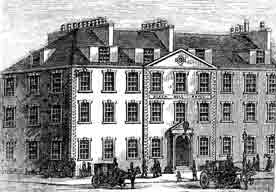Black Bull Inn.
Trongate, Glasgow.

The Black Bull Inn, Trongate.
Glasgow's first theatre was erected against the wall of the Bishop's Palace, near the Cathedral. It was a primitive wooden shack. It was opened as the Castle Yard Booth, between 1752-1754. Reverend George Whitfield declared it a den of iniquity and burned it to the ground.
George Whitfield raised £60 towards the erection of the Black Bull Inn.
In the 1770s Patrick Heron, Vintner at the Black Bull Inn, advertised that there sets out from his house, and from Mrs Gibson's Inn, Grassmarket, Edinburgh, a stage couch to go to Edinburgh by Falkirk and to reach Edinburgh that evening and run it from Glasgow upon Mondays, Wednesdays and Fridays, and from Edinburgh on Tuesdays, Thursdays and Saturdays.
The Black Bull Inn was founded by the Highland Gaelic Society in 1759. The Inn was an important stage-coach post which stood facing Stockwell Street where Marks & Spencers now stands at the corner of Glassford Street. Robert Burns stayed at the Black Bull Inn a few times and wrote to his lover Agnes McIehose, because she was a married woman, they feared their affair would be discovered, so to conseal their identities, they signed the letters "Sylvander" and "Clarinda."
The Black Bull stood on the west port of the city at Stockwell, in Argyll Street and here the cattle market was held. At this point, on the south side of Argyll Street, there stood in 1750 a thatched hostelry for drovers, with a swinging sign of a Black Bull. Here was a little draw-well famed for its water, which is remembered in the verse of "The Lament for Captain Paton," one of which runs:- "Or if a bowl was mentioned, The Captain he would ring, And bid Nelly to the West Port, And a stoup of water bring; Then he would mix the genuine stuff, As they made it long ago, With limes that on his property In Trinidad did grow. O! we ne'er shall taste the like Of Captain Pateon's punch no mo'!"
The Inn was built b the Glasgow Highland Society in 1758. In that year the promoters enlisted nine services of the famous preacher George Whitfield, who conducted a service in the Cathedral churchyard, and a generous collection was made for the building fund.
The Inn had accommodation for 38 horses, 40 sleepers, and 5,000 stones of hay, and formed the west most part of the premises lately occupied by Mann, Byars & Co. The two middle storey's, each with nine windows, and the ornamented corners of the original building are still intact, but the attics have been altered and the pediment removed. Robert Burns made it his headquarters in 1787 and 1788, and his amorous effusion to Clarinda was written under its roof. A tablet referring to his association with the inn has this year been affixed to the building by the Scottish Burns Club. The landlord at that time was George Durie.
Argyle Street was named after the duke of that time, and in 1761 the duke lay in state in the Black Bull en route to the graveyard in Kilmun.
The Inn was the headquarters of the Fox Club, a whig one, and the historic address to Queen Charlotte was prepared there, its rival being the Pitt Club, which was Tory. A Literary and Commercial Society held its meetings there also, and among its members and ornaments were Adam Smith, author of the "Wealth of Nations"; David Hume, the historian; and Edward Burke, the orator. It was the favourite place for hunt balls in its day, and was finally transformed into a warehouse in 1849.
End.
